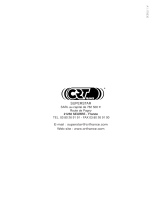
FOR CLASS B UNINTENTIONAL RADIATORS:
This equipment has been tested and found to comply with the limits for a
Class B digital device, pursuant to part 15 of the FCC Rules.
These limits are designed to provide reasonable protection against
harmful interference in a residential installation.
This equipment generates, uses and can radiate radio frequency energy
and, if not installed and used in accordance with the instructions, may
cause harmful interference to radio communications. However, there is
no guarantee that interference will not occur in a particular installation.
If this equipment does cause harmful interference to radio or television
reception, which can be determined by turning the equipment off and on,
the user is encouraged to try to correct the interference by one or more
of the following measures:
Reorient or relocate the receiving antenna. ●
Increase the separation between the equipment and receiver. ●
Connect the equipment into an outlet on a circuit different from that to ●
which the receiver is connected.
Consult the dealer or an experienced radio/TV technician for help. ●
FOR CUSTOMERS IN CANADA :
Le présent appareil est conforme aux CNR d'Industrie Canada applicables
aux appareils radio exempts de licence.
L'ExPLOITATION EST AUTORISéE AUx DEUx CONDITIONS SUIVANTES :
(1) l'appareil ne doit pas produire de brouillage, et
(2) l'utilisateur de l'appareil doit accepter tout brouillage radioélectrique
subi, même si le brouillage est susceptible d'en compromettre le
fonctionnement.
Handling this product
The manufacturer declines any responsibilities against loss of life and
property due to a failure of this product when used with or as a part of a
device made by third parties.
Be sure to reduce the audio output level to minimum before using an
earphone or a headset. Excessive audio may damage hearing.
Do not open the unit without permission or instruction from the
manufacturer. Unauthorized modification or repair may result in electric
shock, re and/or malfunction and voids warranty.
Do not operate this product in a wet place such as in a shower room. It
may result in electric shock, re and/or malfunction.
Do not place the product in a container carrying conductive materials,
such as water or metal in close proximity. A short-circuit to the product may
result in electric shock, re and/or malfunction.
In case of emergency
In case of the following situation(s), please turn off the product,
switch off the source of power, then remove or unplug the power-
cord. Please contact your local dealer of this product for service
and assistance. Do not use the product until the trouble is
resolved. Do not try to troubleshoot the problem by yourself.
When a strange sound, smoke and/or strange odor comes out ●
of the product.
When the product is dropped or the case is broken or cracked. ●
When a liquid penetrated inside. ●
When a power cord (including DC cables, AC cables and ●
adapters) is damaged
For your safety, turn off then remove all related AC lines to the product and
its accessories from the wall outlet if a thunderstorm is likely.
PRECAUTIONS:
Use of third party accessory may result in damage to this product. It will void
our warranty for repair.
Maintenance
Do not open the unit and its accessories. Please consult with your local
dealer of this product for service and assistance





















